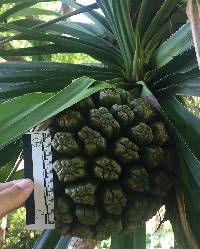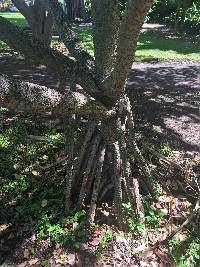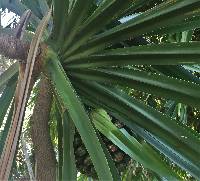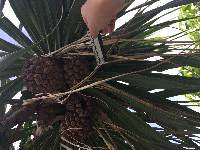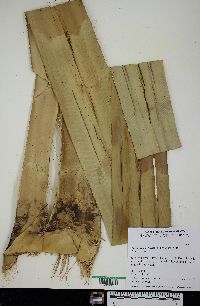
|
|
|
|
Family: Pandanaceae
[Pandanus ala-kai Martelli, morePandanus baptistii Misonne, Pandanus crustatus Martelli, Pandanus distinctus Martelli, Pandanus divergens Kaneh., Pandanus duriocarpus Martelli, Pandanus fischerianus Martelli, Pandanus guamensis Martelli, Pandanus macfarlanei Martelli, Pandanus meetiaensis H.St.John, Pandanus mei F.Br., Pandanus obliquus Kaneh., Pandanus odoratissimus var. laevigatus Martelli, Pandanus papeariensis Martelli, Pandanus tessellatus Martelli, Pandanus veitchii Mast.] |
Wagner, Warren L., Derral R. Herbst and S. H. Sohmer. 1999. Manual of the Flowering Plants of Hawaii [/? chamissonis Gaud.; P. douglasii Gaud.; P men- ziesii Gaud.; P. odoratissimus sensu Hillebr. and Rock, non L. fil.; P. o. var. levigatus Martelli; P. o. var. oahuensis Martelli; P. tectorius var. chamissonii (Gaud.) Martelli; P. t. var. douglasii (Gaud.) Martelli; P. t. var. levigatus (Martelli) B. Stone; P. t. var. oahuensis (Martelli) B. Stone; P. t. var. sandvicensis Warb.] (ind?) Hala, pu hala Small trees up to ca. 10 m tall, with an erect or ascending trunk, branching dichotomously or trichotomously, supported at base by several to numerous thick, rigid, somewhat prickly, ± branched prop roots, sometimes descending from branches. Leaves crowded near branch ends, coriaceous, usually somewhat glaucous on lower surface, linear-ensiform, usually arcuate, sometimes twisted, usually 80-180 cm long, 4-8 cm wide, midrib keeled on lower surface, ± with small retrorse or antrorse prickles, longitudinal nerves evident, crossnerves usually obscure, margins with antrorse green or greenish brown-tipped prickles up to 4 mm long, apex attenuate. Inflorescences terminal, pendent in fruit, pedunculate, bracteate, the bracts white to cream-colored; staminate inflorescences (excluding lower peduncle) usually 30-45 cm long, fertile bracts usually 13-18, spikes cream-colored, oblong, compressed, up to ca. 10 cm long, consisting of numerous crowded staminate phalanges, these columnar, stamens racemose, often 12—18(—30) per cluster, filaments distinct, 1-3 mm long, pollen white; pistillate inflorescence a sub- erect solitary head, usually closely enveloped by bracts, each head globose to ovoid- ellipsoid, ca. 5 cm in diameter at anthesis, ripening to 10-20 cm long and 10-18 cm in diameter, phalanges often 40-80 per head, ripe phalanges usually obovoid, usually 4-7 cm long, slightly compressed, the apex low- convex to subtruncate, each carpel apex distinct, capped by the ± slightly elevated stigma, stigmas ovate-deltate to reniform, usually 1-2 mm wide. Phalanges forming poly drupes with usually 5-11 cells, pericarp at least proximally yellow, orange, or red when ripe, slightly fleshy-fibrous below, distally similar in color or greenish, upper mesocarp with spongy pith and, with age, with cavities and fibrous, lower mesocarp fibrous, endocarp reddish brown, bony. Seed chambers fusiform-ellipsoid, usually 8-15 mm long. [2n = ca. 51*, 54*, 60*.] Occurring on Pacific islands of Polynesia, Melanesia, Micronesia, also New Caledonia to northern Australia, New Guinea, west to the Philippines, Moluccas, and Java; in Hawai‘i occurring in extensive groves or intermingled with species such as Aleurites, Psidium, or Acacia, in mesic coastal sites, also on low elevation slopes of mesic valleys further inland, 0-610 m, rarely higher, on all of the main islands except Kaho‘olawe.—Plate 217. Four types of hala were recognized by the Hawaiians based upon the color of their fruit: common hala with yellow phalanges; hala fula with orange phalanges; hala lihi- lihi fula with phalanges red fading to yellowish below; and hala pia with small and pale yellow phalanges. The tree was of great value to the Hawaiians; most of its parts had individual names and uses. These are discussed by Handy and Handy (1972) and B. Krauss (1974). Phalanges are often used in lei; old dry phalanges were used as brushes, as for dying kapa. Leaves are still commonly woven or plaited into useful items such as mats (lau hala mats), hats, bags, and purses, and were formerly used as thatch. Roots may be retted to yield a cordage fiber, although that obtained from Freycinetia is preferable (generally longer and also stronger). Seeds are edible, while the phalange lower mesocarp is less so because it is rich in calcium oxalate crystals, and must be cooked. Warburg (1900) placed the Hawaiian plants in Pandanus tectorius, and earlier botanists used other names. Stone (1967d) has shown that the closely related P. tectorius and P. odoratissimus can be dis-criminated by a few characteristics and by nearly distinct geographical distributions. Basically, P. tectorius is more eastern in distribution (Polynesia, Melanesia, Australia, Micronesia), while P. odoratissimus is more western (Malaysia, Sri Lanka, India). The variation in both species known across this vast area is extensive and complex. Attempts to discriminate numerous local segregate species have been made. The 6 varieties recognized by Martelli (1930) for Hawai‘i were characterized entirely on fruit, and thus staminate plants, juveniles, or non-fruiting trees can not be identified. These “carpological forms” are unlikely to be worthy of formal recognition (most are probably genetic strains or cultivars). Evidence bearing on the native status of Pandanus tectorius in Hawai‘i is inconclusive. Since this species is distributed by sea- drifted fruit from island to island, it may well have reached the Hawaiian Islands before humans did. However, as the plant is a useful one, it has also been spread by humans, and thus it may have been an early Polynesian introduction. For that matter, the Hawaiian populations may be derived from a number of introductions by natural and human means. Observations on phenology are not available, but comparable evidence (from other Pacific Islands) suggests that flowering of staminate trees may occur at intervals of about 60 days, while pistillate trees likely flower 1-3 times per year. Staminate trees are often more branched as a consequence. Fruit takes several months to ripen. Pistillate trees often produce viable seeds through apomixis. Various cultivars of Pandanus tectorius are grown. These include a form with spineless leaves (var. laevis Warb.), several with partly albino, striped leaves, and one with the lower part of the phalanges red. |

Development of the Consortium of Pacific Herbaria and several of the specimen databases have been
supported by National Science Foundation Grants (BRC 1057303,
ADBC 1304924
and ADBC1115116).
Data Usage Policy. Continued support provided by the Symbiota Support Hub, a domain of iDigBio (NSF Award #2027654).
Copyright 2015 University of Hawai‘i.



